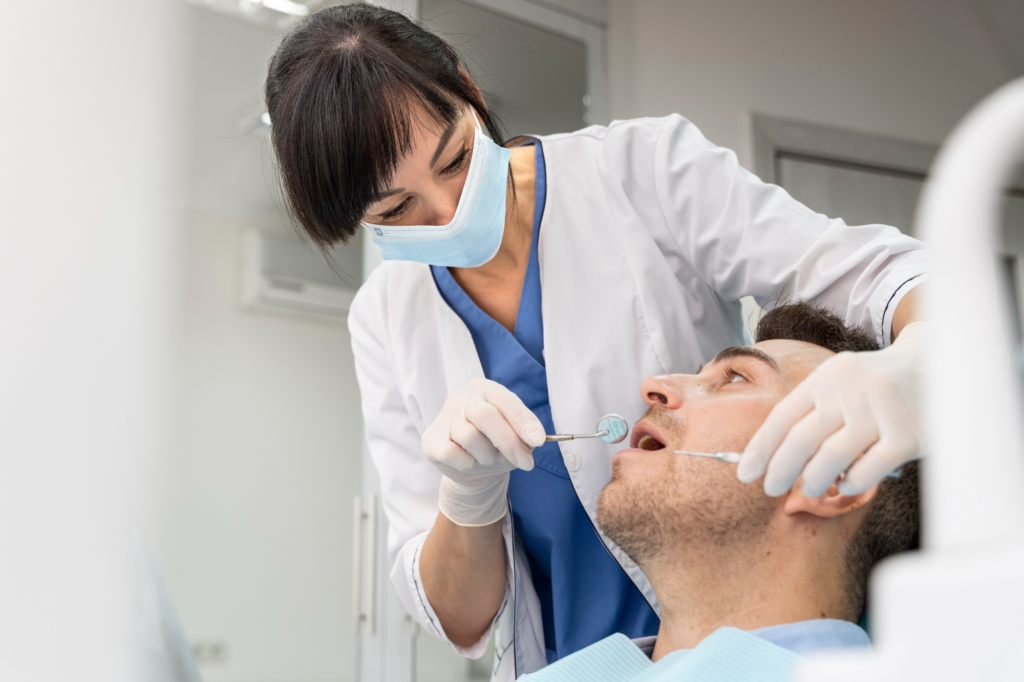Leukoplakia is a condition that shows up as white patches in the mouth. These patches can, at times, be pre-cancerous. That’s why catching them early is so important. Regular dental check-ups play a massive role in spotting leukoplakia before it escalates into something more serious. Think of these visits as a preventive measure, much like how car maintenance helps avoid breakdowns. Crucially, the earlier professionals diagnose leukoplakia symptoms, the better your chances of effectively managing the condition. Regular appointments with your dentist are a simple yet vital step for ensuring your oral health remains optimal.
Understanding Leukoplakia
Let’s first define leukoplakia. It’s recognized as a condition where thick, white patches form in the mouth. These patches can be painless and found inside the cheeks, on the gums, and sometimes near the floor of the mouth. The definition of leukoplakia also includes leukoplakia types, like hairy oral leukoplakia. This particular type is often seen in those with compromised immunity, such as individuals with HIV.
The white patches in the mouth, identified as leukoplakia disease, vary from one person to another. Some might even notice a rough surface or speckled leukoplakia. By knowing these manifestations, you can better monitor any changes inside your mouth.
Causes and Risk Factors
Have you ever wondered about the causes of leukoplakia oral? Tobacco use, whether it’s smoking cigarettes or chewing tobacco, is a primary risk factor. Excessive alcohol consumption also raises your chances. In some cultures, chewing areca nuts is common, and this too can increase risks. Interestingly, irritation from dental appliances, like braces, can also be a cause of leukoplakia.
Hairy oral leukoplakia links back to the Epstein-Barr virus. While this might sound a bit complex, it’s essential to know that oral health involves multiple factors. Understanding these risks helps in taking steps toward prevention.
Recognizing Warning Signs and Symptoms
Spotting leukoplakia symptoms early is crucial. These patches are typically uneven and might feel rough against your tongue. Unlike some benign mouth conditions, leukoplakia in mouth lingers longer and doesn’t rub off. If you notice any such patches, consulting a dentist is key. Immediate professional advice can prevent further complications. Keep a lookout for other oral leukoplakia symptoms that might signal a need for prompt medical attention.
Leukoplakia and the Cancer Connection
The stakes are high when it comes to leukoplakia oral. Studies link these white patches to an increased risk of oral cancer. If left unchecked, leukoplakia tongue could morph into something more severe. Various factors amplify this risk, like continuing to smoke or drink excessively. By being vigilant and proactive, you can potentially avert significant health issues.
Harnessing the Power of Early Detection
Routine check-ups are your powerful ally. They allow dental experts to catch leukoplakia disease early. Without intervention, the condition can progress. If detected in its infancy, timely treatment can lead to favorable outcomes. Moreover, spotting oral leukoplakia tongue in earlier stages saves not just health but also money. Treating conditions early means fewer expensive measures down the line. Regular dental visits are a smart, economical choice that keeps both your health and pocket in check.
Recommended Check-up Schedule
How often should you visit the dentist? It depends. For the general population, twice a year is the norm. If you have risk factors, like a history of leukoplakia, you might need more frequent visits. An oral cancer screening is part of these check-ups. If something suspicious is found, additional screenings are a wise step to take.
Effective Treatment Options
So, what happens if leukoplakia symptoms are confirmed? There’s a range of treatments. The goal is to address the root causes and remove any bothersome patches. Post-treatment, continuous monitoring ensures the problem doesn’t return. Maintaining vigilance after treatment helps in managing the condition effectively. By taking direct action, you can maintain a healthy mouth.
Proactive Lifestyle Changes for Prevention
A few lifestyle changes can make a big difference. Quit tobacco and cut back on alcohol to significantly reduce risks related to leukoplakia disease. Consider tobacco cessation aids or support groups if you find quitting tough. Regular oral hygiene, like brushing and flossing, helps too. Also, rethink your diet. Eating a balanced diet rich in fruits and vegetables supports a healthy mouth.
Stories of Hope: Impact of Early Diagnosis
There are incredible stories out there. One patient discovered leukoplakia in mouth early in a routine check-up. Thanks to timely intervention, they successfully treated the condition. On the other hand, delaying a diagnosis might lead to more complex outcomes. Early and proactive measures provide peace of mind and healthier prospects.
Empower Yourself: Next Steps Towards Oral Health
Start by scheduling a dentist appointment. Prepare questions about leukoplakia symptoms and other oral health concerns. Arm yourself with knowledge, be it through online resources or books. Adept professionals and credible resources are available to aid in your journey toward better oral health.
Conclusion
In conclusion, regular check-ups are not only about ensuring your well-being but also about maintaining peace of mind. Prioritize your oral health and watchful habits today. Acting proactively can prevent significant health challenges. As the old saying goes, “prevention is better than cure.” Schedule that dentist appointment now, and don’t hesitate to discuss any concerns. After all, your health is your wealth! Prioritize it, nurture it, and never underestimate the power of simple, consistent actions. It’s time to take charge of your oral health journey.


